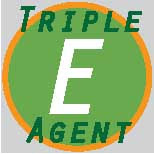 Triple E's last post back in the beginning of May, Enter the Sandman, described what it was like to experience a tornado watch, and tornado warning. The intent of that article was to provide a perspective on the effects of severe 'short-term' rainfall on a sustained drought, with the tornado commentary being related but not a centerpiece. Then on the tragic day of May 20th, 2013, Moore, Oklahoma was hit by a devastating tornado just a few miles north of Triple E headquarters. The hailstorm and tornado warnings of May 19th didn't make the news, but Triple E and every other Sooner in the Oklahoma City area was dodging hail up to the size of baseballs.
Triple E's last post back in the beginning of May, Enter the Sandman, described what it was like to experience a tornado watch, and tornado warning. The intent of that article was to provide a perspective on the effects of severe 'short-term' rainfall on a sustained drought, with the tornado commentary being related but not a centerpiece. Then on the tragic day of May 20th, 2013, Moore, Oklahoma was hit by a devastating tornado just a few miles north of Triple E headquarters. The hailstorm and tornado warnings of May 19th didn't make the news, but Triple E and every other Sooner in the Oklahoma City area was dodging hail up to the size of baseballs.Hail (photo above) collected in Norman, OK on May 19th, 2013. Former residential development (photo below) in Western Moore, OK taken on May 25th, 2013.
 After the May 20th tornado many questions were directed to scientists from the midcontinent. Are there geologic, hydrologic anomalies that could be related to strength of tornadoes in this part of the country, and could they be used to somehow engineer the landscape with a 'preventative' measure. Interesting questions to consider, but while avoiding hail, taking shelter multiple times, and
watching downpours in May, June and July...Triple E began to wonder two
things:
After the May 20th tornado many questions were directed to scientists from the midcontinent. Are there geologic, hydrologic anomalies that could be related to strength of tornadoes in this part of the country, and could they be used to somehow engineer the landscape with a 'preventative' measure. Interesting questions to consider, but while avoiding hail, taking shelter multiple times, and
watching downpours in May, June and July...Triple E began to wonder two
things:Why is Triple E not on Twitter? If ever there was a time that it made sense to Tweet - it was in late May. It would have been much easier for Triple E to message people around the world about the dynamic situation.
Did Triple E's statement 'We would need a two- to three-year period of higher-than-average precipitation to balance out the previous two to three dry years' hold water?
Triple E Agent Assignment:
Update the drought status after an historic tornado season...So, what's the scoop?

















